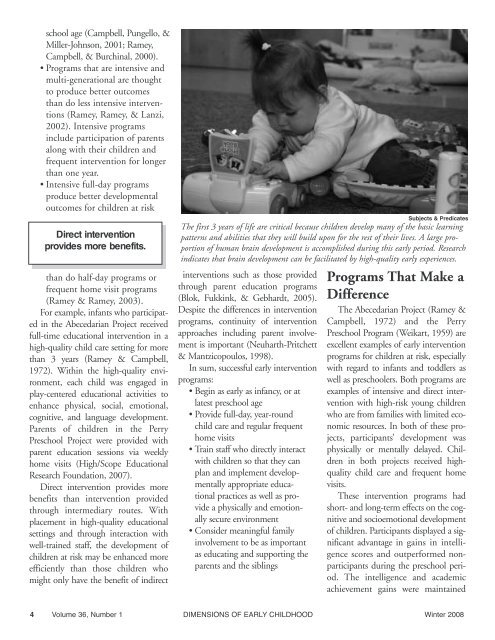Early Intervention Programs for Infants and Toddlers at Risk
Early Intervention Programs for Infants and Toddlers at Risk
Early Intervention Programs for Infants and Toddlers at Risk
Create successful ePaper yourself
Turn your PDF publications into a flip-book with our unique Google optimized e-Paper software.
school age (Campbell, Pungello, &<br />
Miller-Johnson, 2001; Ramey,<br />
Campbell, & Burchinal, 2000).<br />
• <strong>Programs</strong> th<strong>at</strong> are intensive <strong>and</strong><br />
multi-gener<strong>at</strong>ional are thought<br />
to produce better outcomes<br />
than do less intensive interventions<br />
(Ramey, Ramey, & Lanzi,<br />
2002). Intensive programs<br />
include particip<strong>at</strong>ion of parents<br />
along with their children <strong>and</strong><br />
frequent intervention <strong>for</strong> longer<br />
than one year.<br />
• Intensive full-day programs<br />
produce better developmental<br />
outcomes <strong>for</strong> children <strong>at</strong> risk<br />
Direct intervention<br />
provides more benefits.<br />
than do half-day programs or<br />
frequent home visit programs<br />
(Ramey & Ramey, 2003).<br />
For example, infants who particip<strong>at</strong>ed<br />
in the Abecedarian Project received<br />
full-time educ<strong>at</strong>ional intervention in a<br />
high-quality child care setting <strong>for</strong> more<br />
than 3 years (Ramey & Campbell,<br />
1972). Within the high-quality environment,<br />
each child was engaged in<br />
play-centered educ<strong>at</strong>ional activities to<br />
enhance physical, social, emotional,<br />
cognitive, <strong>and</strong> language development.<br />
Parents of children in the Perry<br />
Preschool Project were provided with<br />
parent educ<strong>at</strong>ion sessions via weekly<br />
home visits (High/Scope Educ<strong>at</strong>ional<br />
Research Found<strong>at</strong>ion, 2007).<br />
Direct intervention provides more<br />
benefits than intervention provided<br />
through intermediary routes. With<br />
placement in high-quality educ<strong>at</strong>ional<br />
settings <strong>and</strong> through interaction with<br />
well-trained staff, the development of<br />
children <strong>at</strong> risk may be enhanced more<br />
efficiently than those children who<br />
might only have the benefit of indirect<br />
Subjects & Predic<strong>at</strong>es<br />
The first 3 years of life are critical because children develop many of the basic learning<br />
p<strong>at</strong>terns <strong>and</strong> abilities th<strong>at</strong> they will build upon <strong>for</strong> the rest of their lives. A large proportion<br />
of human brain development is accomplished during this early period. Research<br />
indic<strong>at</strong>es th<strong>at</strong> brain development can be facilit<strong>at</strong>ed by high-quality early experiences.<br />
interventions such as those provided<br />
through parent educ<strong>at</strong>ion programs<br />
(Blok, Fukkink, & Gebhardt, 2005).<br />
Despite the differences in intervention<br />
programs, continuity of intervention<br />
approaches including parent involvement<br />
is important (Neuharth-Pritchett<br />
& Mantzicopoulos, 1998).<br />
In sum, successful early intervention<br />
programs:<br />
• Begin as early as infancy, or <strong>at</strong><br />
l<strong>at</strong>est preschool age<br />
• Provide full-day, year-round<br />
child care <strong>and</strong> regular frequent<br />
home visits<br />
• Train staff who directly interact<br />
with children so th<strong>at</strong> they can<br />
plan <strong>and</strong> implement developmentally<br />
appropri<strong>at</strong>e educ<strong>at</strong>ional<br />
practices as well as provide<br />
a physically <strong>and</strong> emotionally<br />
secure environment<br />
• Consider meaningful family<br />
involvement to be as important<br />
as educ<strong>at</strong>ing <strong>and</strong> supporting the<br />
parents <strong>and</strong> the siblings<br />
<strong>Programs</strong> Th<strong>at</strong> Make a<br />
Difference<br />
The Abecedarian Project (Ramey &<br />
Campbell, 1972) <strong>and</strong> the Perry<br />
Preschool Program (Weikart, 1959) are<br />
excellent examples of early intervention<br />
programs <strong>for</strong> children <strong>at</strong> risk, especially<br />
with regard to infants <strong>and</strong> toddlers as<br />
well as preschoolers. Both programs are<br />
examples of intensive <strong>and</strong> direct intervention<br />
with high-risk young children<br />
who are from families with limited economic<br />
resources. In both of these projects,<br />
participants’ development was<br />
physically or mentally delayed. Children<br />
in both projects received highquality<br />
child care <strong>and</strong> frequent home<br />
visits.<br />
These intervention programs had<br />
short- <strong>and</strong> long-term effects on the cognitive<br />
<strong>and</strong> socioemotional development<br />
of children. Participants displayed a significant<br />
advantage in gains in intelligence<br />
scores <strong>and</strong> outper<strong>for</strong>med nonparticipants<br />
during the preschool period.<br />
The intelligence <strong>and</strong> academic<br />
achievement gains were maintained<br />
4 Volume 36, Number 1 DIMENSIONS OF EARLY CHILDHOOD Winter 2008
















